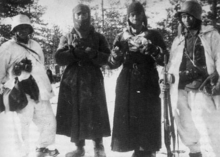Telogreika: Difference between revisions
m Undid revision 1177735807 by Altenmann It is obviously similar. Both are jackets padded with cotton wool, but from a different time period. |
|||
| Line 25: | Line 25: | ||
[[File:Red Army POWs in Winter War.png|thumb|Soviet prisoners of war captured during the Winter War, with issued shinels]] |
[[File:Red Army POWs in Winter War.png|thumb|Soviet prisoners of war captured during the Winter War, with issued shinels]] |
||
The telogreika faded from military issue in the early 1960s, being largely replaced by the return of the old woollen ''shinel'' [[greatcoat]] and the ''bushlat'' [[pea coat]]. In the early 1980s, the introduction of the [[Afghanka]] field uniform marked the dawn of a new era in the [[Soviet Army]]. Today, the telogreika is still used in Russia and many former [[Eastern Bloc]] countries by private citizens. In Russia, it remains popular amongst night [[watchman (law enforcement)|watchmen]], [[construction worker]]s and the homeless. |
The telogreika faded from military issue in the early 1960s, being largely replaced by the return of the old woollen ''shinel'' [[greatcoat]] and the ''bushlat'' [[pea coat]]. In the early 1980s, the introduction of the [[Afghanka]] field uniform marked the dawn of a new era in the [[Soviet Army]]. Today, the telogreika is still used in Russia and many former [[Eastern Bloc]] countries by private citizens. In Russia, it remains popular amongst night [[watchman (law enforcement)|watchmen]], [[construction worker]]s and the homeless. |
||
==See also== |
|||
* [[Gambeson]] |
|||
== Sources == |
== Sources == |
||
Revision as of 11:01, 29 September 2023
This article needs additional citations for verification. (January 2010) |
The telogreika (Russian: телогре́йка, lit. 'body warmer', IPA: [tʲɪlɐˈgrʲejkə]) or vatnik (Russian: ватник, IPA: [ˈvatnʲɪk]) is a variety of Russian warm cotton wool-padded jacket. It was also a part of the winter uniform first issued by the Red Army during World War II.[citation needed] Telogreikas continued to be issued until the late 1960s.[citation needed]
Variations

The earlier 1935 vatniks resembled a modern wool jacket in shape and cut. Issued extensively from 1935 to 1941, with a simplified version from 1941 onwards.
The basic cut the uniform followed was that of a quilted jacket and quilted trousers. The trousers had a button fly and were tied at the bottom of the legs. There were usually pockets on the hips of the trousers and a button pocket on the front of the trouser leg.
Telogreika jackets buttoned up the front, and the jacket sleeves buttoned closed. Early issue variants had high collars, though these were absent later on. Telogreika jackets usually had a single pocket on the front of the jacket.
The clothing was usually khaki in colour, although black uniforms were issued to tank crews and some grey variants can be seen, sewn of cotton (and later polyester-blend) fabric with a cotton wool batting inside.
The jacket and trousers usually had a ribbed design with the quilting, although this feature was absent on many of the non-Soviet issue uniforms.
Effectiveness
When worn with valenki and an ushanka, the wearer can comfortably remain warm in sub-zero temperatures for long periods. This made it an ideal uniform for the Red Army and for the guards of the Gulag.[citation needed]
Issue


The telogreika faded from military issue in the early 1960s, being largely replaced by the return of the old woollen shinel greatcoat and the bushlat pea coat. In the early 1980s, the introduction of the Afghanka field uniform marked the dawn of a new era in the Soviet Army. Today, the telogreika is still used in Russia and many former Eastern Bloc countries by private citizens. In Russia, it remains popular amongst night watchmen, construction workers and the homeless.
See also
Sources
- Békési, László (2006). Stalin's War: Soviet Uniforms & Militaria 1941–45 in Colour Photographs. Photographs by György Török. Ramsbury, Marlborough: The Crowood Press. ISBN 1-86126-822-X.
- Zaloga, Steven J. (1984). The Red Army of the Great Patriotic War, 1941–45. Men-at-Arms. Vol. 216. Colour plates by Ron Volstad. Oxford: Osprey Publishing. ISBN 0-85045-939-7.
